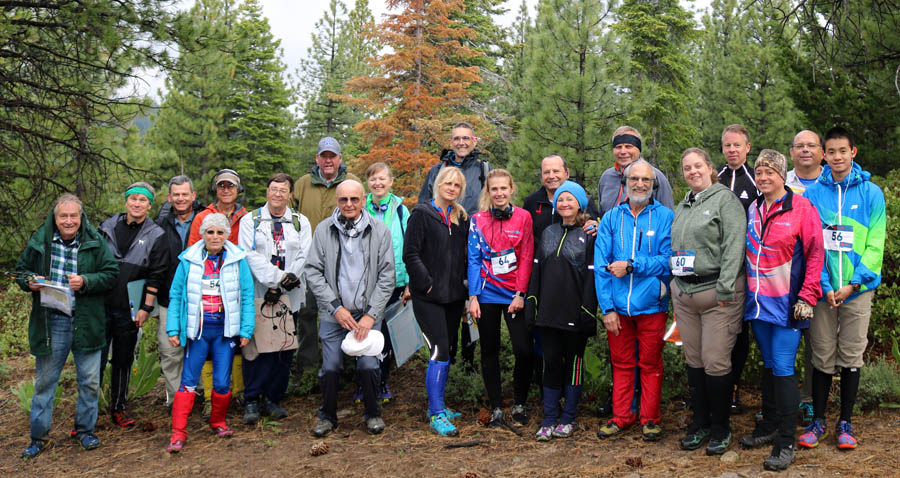
Competitors and the Meet Director just before the start of the 80-meter classic event. (Photo by Woody Jackson. Click photo for larger version.)

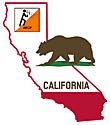 Which state has the best places for orienteering and on-foot Amateur Radio Direction Finding (ARDF)?
Which state has the best places for orienteering and on-foot Amateur Radio Direction Finding (ARDF)?
Hams in North Carolina, Ohio and some other eastern states claim that their dense forests, many of them well mapped, are ideal. Western states have some great mountain sites that will test your map, compass and direction-finding skills at high altitude. The area around Albuquerque, New Mexico is a favorite. But there are even more great mountain sites in California.
Our national championships of ARDF, which is also called radio-orienteering, have taken place in the Golden State four times. In 2007, the site was along the south shore of Lake Tahoe in the Sierra Mountains. Competitors were able to run point-to-point among the tall trees. Temperatures dipped into the 30s overnight but stayed in the 70s throughout the competition times.
Not far away on the other side of the big lake is the town of Truckee. It sits along Interstate 80, one hundred miles northeast of Sacramento and thirty-three miles southwest of Reno, Nevada. It is best known as a wintertime haven for skiers, close to the famous Donner Summit. North of Truckee in the Tahoe National Forest is the area around Little Truckee Summit (LTS), which is similar to the 2007 site but much larger.
In 2012, the Bay Area Orienteering Club (BAOC) commissioned a map covering 3,400 acres around LTS. The result is one of the finest orienteering maps in the USA. The mapped area is so large that there is ample space for separate two-meter and 80-meter courses plus a sprint and a foxoring course. It was perfect for the USA ARDF Championships this year.
The Tahoe National Forest is beautiful in June, with only a little remaining snow and lots of wildflowers. Ticks and poison oak aren't problems. Nobody encountered a bear or mountain lion while running among the tall fir and pine trees.
42 Transmitters in the Woods
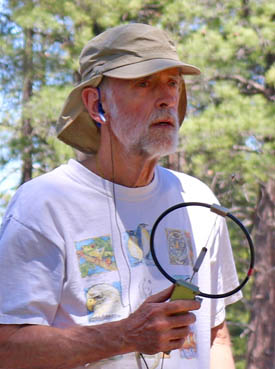 Bob Cooley KF6VSE (at left) of Pleasanton, California is Mapping Director for BAOC. His close familiarity with LTS made him the perfect Course Designer for the championships. Bob has been radio-orienteering since 2000 and has won numerous ARDF medals at the USA and World Championships. He placed 42 transmitters, flags and electronic scoring stations in the forest over the five days of the championships, not counting the finish beacons. Everyone agreed that the courses he set were difficult, but fair.
Bob Cooley KF6VSE (at left) of Pleasanton, California is Mapping Director for BAOC. His close familiarity with LTS made him the perfect Course Designer for the championships. Bob has been radio-orienteering since 2000 and has won numerous ARDF medals at the USA and World Championships. He placed 42 transmitters, flags and electronic scoring stations in the forest over the five days of the championships, not counting the finish beacons. Everyone agreed that the courses he set were difficult, but fair.
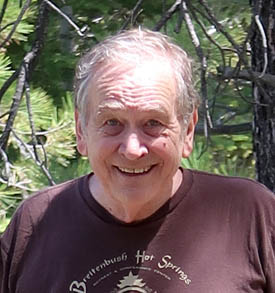 Working with BAOC, Bob also served as Registrar for the championships. Attending to all of the other details of the competitions was Jay Hennigan WB6RDV (at right) of Gates, Oregon, who served as the Meet Director. Jay has won medals at the USA and International Amateur Radio Union (IARU) Region 2 Championships, so he knows the secrets of a well-organized ARDF meet. In addition to starting-line operations, Jay was responsible for the medals and the commemorative T-shirts.
Working with BAOC, Bob also served as Registrar for the championships. Attending to all of the other details of the competitions was Jay Hennigan WB6RDV (at right) of Gates, Oregon, who served as the Meet Director. Jay has won medals at the USA and International Amateur Radio Union (IARU) Region 2 Championships, so he knows the secrets of a well-organized ARDF meet. In addition to starting-line operations, Jay was responsible for the medals and the commemorative T-shirts.
Bob and Jay had excellent assistance from Tom Gaccione WB2LRH, Bob Houghton AD6QF and Woody Jackson. These volunteers were stationed at the equipment impound area, the map table, the start line, and the finish line.
International ARDF championships follow a set of rules that has been developed by the IARU to insure fairness and uniformity. There are specifications for course location and design, transmitters and receivers, start/finish operations and competitor eligibility. Participants are divided into eleven age/gender categories. Males in the prime age group (21 through 39) are required to find all transmitters. Those in other categories find fewer; the required transmitters for each category vary and are announced prior to the start.
Some participants arrived early for an informal practice day on Wednesday, June 13 at Logger Campground near Stampede Reservoir. KF6VSE set a half-length five-fox two-meter course in the morning and a similar 80-meter course in the afternoon. It was great training for first-timers and a nice warm-up for those with more experience. Regardless of IARU category, all participants were encouraged to find all transmitters.
The gathering place for all of the remaining days was the parking lot at LTS. The first formal event was foxoring on Thursday. After changing into their course clothes, competitors walked to the starting area. They were called up in small groups at two-minute intervals to the map table, where they could mount their map to a map board if they desired. Then two minutes later, they started down the starting corridor and into the forest. The persons in each starting group were in different age/gender categories, which meant that they were searching for different transmitter numbers and would scatter at the end of the start corridor.
Foxoring is a hybrid of orienteering and RDF in which competitors receive a map marked with ten small circles. They are to orienteer their way to the location represented by each circle and find the transmitter somewhere therein. The foxes run very low power and often cannot be heard outside their circles. As always in ARDF, scoring is first by number of required foxes found and second by elapsed start-to-finish time.
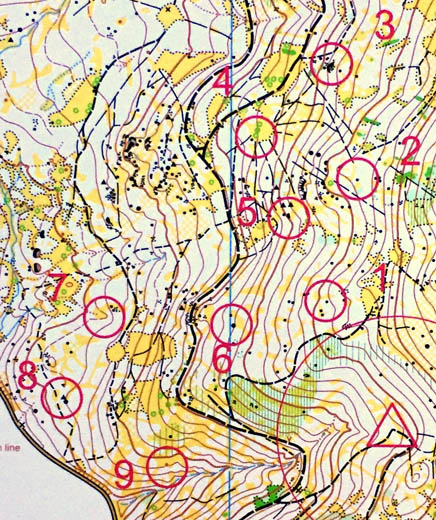
Everyone was back at LTS Friday morning for the sprint. Some transmitters were copyable in the starting area, so all competitors' equipment was impounded to prevent anyone from gaining early bearings. The sprint is an 80-meter event with two five-fox short courses, each course on a different frequency with twelve-second transmissions to give a complete cycle every minute. Sprint and foxoring are still relatively new to most radio-orienteers, as they were included for the first time when California hosted the USA Championships in 2012.
Five Foxes in Five Miles
The classic ARDF events of the weekend followed the same IARU format that has prevailed at international events for almost forty years. Five "foxes" transmit for sixty seconds each in rotating sequence. Competitor groups set out just as number one comes on the air. They must find the required transmitters for their category and then get to the finish, which is in a different location from the start. Transmitters may be found in any order. Start and finish locations are marked on the map, but that's all. There is a continuous transmitter on another frequency near the finish to help those who get lost, lose their map or break their glasses.
The Saturday morning course was on two-meters with tone-modulated AM transmitters, per IARU rules. The Sunday course was on the low end of eighty meters with CW transmitters. Almost all competitors use yagi antennas for RDF on two meters. For eighty meters, some use loop antennas of about eight inches diameter, while others prefer ferrite rod antennas for RDF.
Point-to-point from start to each of the five transmitters and then to the finish on the two-meter course was 5.6 kilometers, but such a direct route would have encountered some steep hills. A better choice for most was to utilize the trails, because all transmitters were within 200 meters of a major trail. However, taking the trails and flatlands exclusively increased the total distance to 8.3 kilometers, or about five miles.
There was a three-hour individual time limit on the classic courses. Anyone staying on the course beyond the limit would be disqualified. This year, nobody was overtime in the classic events. The longest time was 16 minutes under the limit. Andres Viira, a visitor from Estonia, completed the two-meter course in less than an hour. Under an hour in the 80-meter course were Illia Ivanko and Vadim Afonkin KB1RLI.
After Saturday's contest, competitors showered and changed into fresh clothes for the traditional evening awards banquet. Gold, silver and bronze medals were awarded in each age/gender category for foxoring, sprint and two-meter classic. Thanks to electronic scoring, the medals for Sunday's event were given out shortly after the last finisher came in.
Besides the medals, some of the participants were hoping that their course performances would win them positions on ARDF Team USA, which travels to Sokcho, Korea in early September for the ARDF World Championships. IARU rules limit national teams to three persons per age/gender category. These rules require team members to either be citizens of the country that they represent or to be residents there for at least one year.
Taking first place awards among USA-eligible competitors for the four events, in alphabetical order, were Vadim Afonkin KB1RLI (M50 sprint 2m 80m), Alexandra Bondarenco (W21 foxor sprint 2m 80m), Natalia Bondarenco (W35 sprint 80m), Ruth Bromer WB4QZG (W60 foxor sprint 2m 80m), Thomas Chen (M19 2m 80m), Kenneth Harker WM5R (M40 foxor sprint 2m), Joseph Huberman K5JGH (M60 foxor sprint 2m 80m), Illia Ivanko (M21 foxor sprint 80m), Harley Leach KI7XF (M70 foxor sprint 2m 80m), Alla Mezhevaya (W35 foxor 2m), Eduard Nasybulin (M21 2m), Kelly Sears (W50 foxor sprint 2m 80m), Patrick Sears AK4JE (M40 sprint 80m) and William Wright WB6CMD (M50 foxor).
Over 50 photos of the championships are now in this site. The legacy Event Information Page remains in this site, including the schedule, transmitter frequencies and directions, plus details about maps, transportation, lodging, site rules, weather and much more. This was also the source of the latest updates about the gathering locations and times for each day's events.
Here are links to the official results.
Portions of this report have been excerpted from my Homing In column in the September 2018 issue of CQ Amateur Radio magazine.
Joe Moell KØOV
Text and photos copyright © 2018 Joseph D. Moell. All rights reserved.
Go to Championships Foxhunting News -- Recent and upcoming ARDF championships events
Go to International-Style Foxhunting Comes To The Americas -- How we're getting the ball rolling
Go to Equipment Ideas for Radio-Orienteering -- Simple and inexpensive receiving and transmitting solutions
Go to Radio-Orienteering News for Southern California -- Results and stories of recent radio-orienteering events in southern California, plus announcements of upcoming ones.
Go to Foxhunting for Scouts -- Let's get the kids involved
This page updated 5 November 2018
Sprint results, Friday, June 15
Two-meter classic results, Saturday, June 16
Eighty-meter classic results, Sunday, June 17
USA ARDF Coordinator

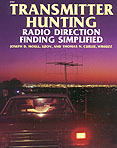 Go to First photo page of this event
Go to First photo page of this event Back to the Homing In home page
Back to the Homing In home page